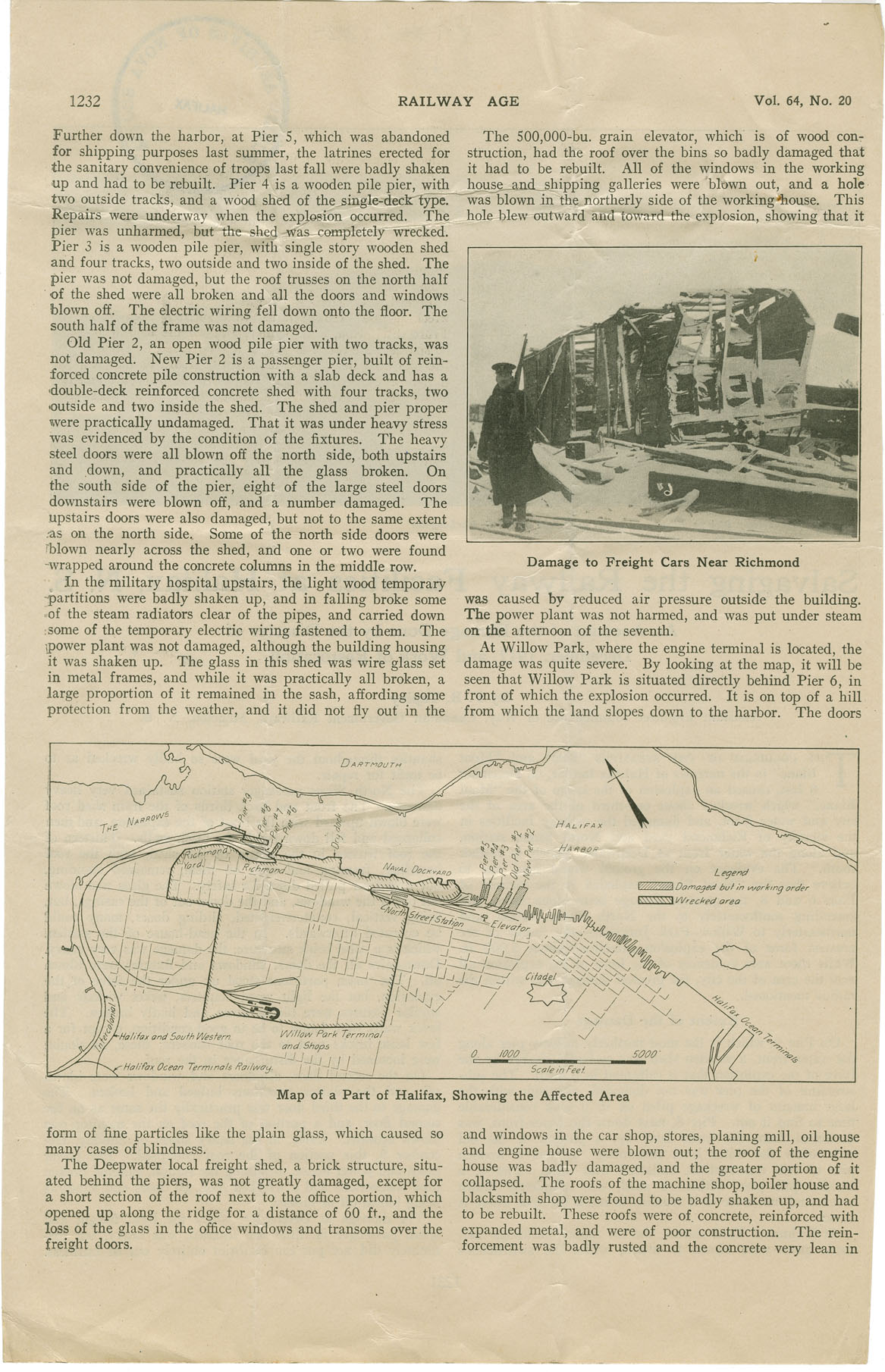Nova Scotia Archives
Archibald MacMechan
Halifax Disaster Record Office Materials
"Salvaging the Railway Facilities at Halifax, Nova Scotia", by F.B. Tapby in "Railway Age".
4 pages : 30 x 47 cm.
note: transcription publicly contributed - please contact us with comments, errors or omisions
1232 Railway Age volume 64, No.20
Further down the harbor, at Pier 5, which was abandoned for shipping purposes last summer, the latrine erected for the sanitary convenience of troops last fall were badly shaken up and had to be rebuilt. Pier 4 is a wooden pile pier, with two outside tracks, and a wood shed of the single-deck type. Repairs were underway when the explosion occurred. The pier was unharmed, but the shed was completely wrecked. Pier 3 is a wooden pile pier, with single story wooden shed and four tracks, two outside and two inside of the shed. The pier was not damaged, but the roof trusses on the north half of the shed were all broken and all the doors and windows blown off. The electric wiring fell down onto the floor. The south half of the frame was not damaged.
Old Pier 2, an open wood pile pier with two tracks, was not damaged. New Pier 2 is a passenger pier, built of reinforced concrete pile construction with a slab deck and has a double-deck reinforced concrete shed with four tracks, two outside and two inside the shed. The shed and pier proper were practically undamaged. That it was under heavy stress was evidenced by the condition of the fixtures. The heavy steel doors were all blown off the north side, both upstairs and down, and practically all the glass broken. On the south side of the pier, eight of the large steel doors downstairs were blown off, and a number damaged. The upstairs doors were also damaged, but not to the same extent as on the north side. Some of the north side doors were blown nearly across the shed, and one or two were found wrapped around the concrete columns in the middle row.
In the military hospital upstairs, the light wood temporary partitions were badly shaken up, and in falling broke some of the steam radiators clear of the pipes, and carried down some of the temporary electric wiring fastened to them. The power plant was not damaged, although the building housing it was shaken up. The glass in this shed was wire glass set in metal frames, and while it was practically all broken, a large proportion of it remained in the sash, affording some protection from the weather, and it did not fly out in the form of fine particles like the plain glass which caused so many cases of blindness.
The Deepwater local freight shed, a brick structure, situated behind the piers, was not greatly damaged, except for a short section of the roof next to the office portion, which opened up along the ridge for a distance of 60 ft., and the loss of glass in the office windows and transoms over the freight doors.
The 500,000-bu grain elevator, which is of wood construction, had the roof over the bins so badly damaged that it had to be rebuilt. All the windows in the working house and shipping galleries were blown out, and a hole was blown into the northerly side of the working house. This hole blew outward and toward the explosion, showing that it was caused by reduced air pressure outside the building. The power plant was not harmed, and was put under steam on the afternoon of the seventh.
At Willow Park, where the engine terminal is located, the damage was quite severe. By looking at the map, it will be seen that Willow Park is situated directly behind Pier 6, in front of which the explosion occurred, It is on top of a hill from which the land slopes down to the harbor. The doors and windows in the car shop, stores, planning mill, oil house, and engine house were blown out; the roof of the engine house was badly damaged, and the greater portion of it collapsed. The roofs were of concrete, reinforced with expanded metal, and were of poor construction. The reinforcement was badly rusted and the concrete very lean in
{Picture on upper rights caption - 'Damage to Freight Cars Near Richmond'}
{Picture on bottoms caption - 'Map of a Part of Halifax, showing the Affected Area}
Reference: Archibald MacMechan Nova Scotia Archives MG 1 volume 2124 number 35

